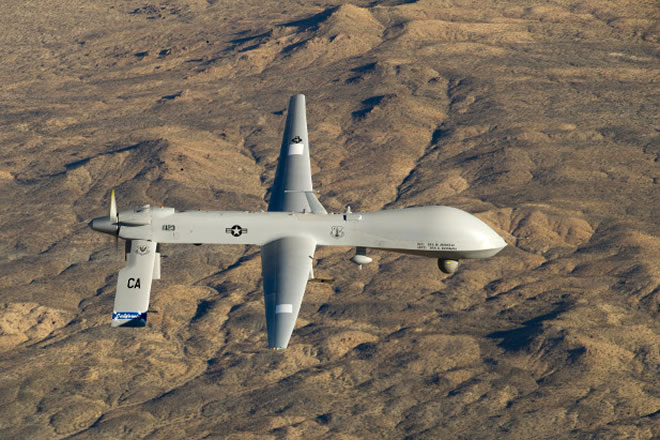
A U.S. Air Force MQ-1 Predator unmanned aerial vehicle assigned to the California Air National Guard's 163rd Reconnaissance Wing flies near the Southern California Logistics Airport in Victorville, California in this January 7, 2012 USAF handout photo obtained by Reuters, February 6, 2013. (U.S. Air Force Tech. Sgt. Effrain Lopez/Courtesy Reuters)
By John Campbell
Wednesday, February 12, 2014
This is a guest post by Allen Grane, intern for the Council on Foreign Relations Africa Studies program. Allen is currently an officer in the Army National Guard. His interests are in Africa, conflict, and conflict resolution.
In the last week of January news outlets reported that an American drone had conducted an unsuccessful strike against a high level al-Shabaab leader in the Lower Shabelle region of Somalia. Later reports stated that the target of the strike was Ahmed Abdi Godane, the presumed current head of al-Shabaab. While the strike failed in its main mission to eliminate Godane, it and other such strikes may represent greater success for American and Somali strategies against the terrorist organization than this single unsuccessful strike.
While Godane is still alive, sources have confirmed that he was in close proximity to the attack. The U.S. military was acting on accurate intelligence, and in fact killed one of Godane’s top aides, Ahmed Abdulkadir Abdullahi, in the attack. In an apparent response to this intelligence leak al-Shabaab recently began abducting the residents of villages in the Lower Shabelle. Of even more importance they are abducting people within their own organization. Four al-Shabaab members have reportedly been arrested.
This response reflects a deterioration in the stability of al-Shabaab as an organization. The breach in their security has forced al-Shabaab to react. Their reaction has been to attack their own members and base of power, as well as residents of al-Shabaab held territories. This kind of reaction may cause a backlash against al-Shabaab by residents within their sphere of activity, and possibly even their own members.
Another successful part of the U.S. mission was just how well the American and Somali governments cooperated. According to Somali officials they were notified of the intelligence and operation prior to its execution. According to Somali government spokesman, Ridwaan Haji Abdiwali, “such operations will help Somalia to be safe from the terrorists hiding in the country.” The cooperation between the Somali government and U.S. forces is key in combating al-Shabaab.
While the future of this conflict is uncertain and it is a difficult task to combat any insurgency, it seems that U.S. forces are moving in the right direction. By creating distrust within al-Shabaab and its power base along with building stronger ties with the Somali government, the U.S. forces are conducting successful counter-insurgency operations. It will be interesting to see if the U.S. continues this strategy and if it will be able to assist in dismantling al-Shabaab in Somalia for good.